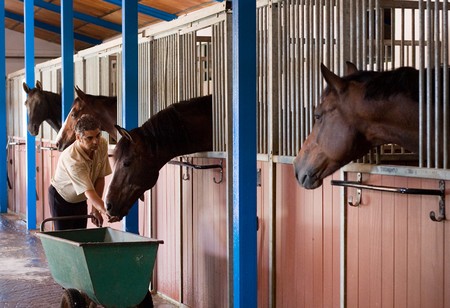A stabled horse requires a good supply of bedding to:
- Encourage it to lie down and rest.
- Reduce the likelihood of injury when lying down.
- Provide warmth and insulation from drafts.
- Reduce the jarring effect of standing on a hard surface for long hours.
- Help keep him and his rugs clean.
Bedding materials
- Straw. This is the most traditional bedding material. It makes a warm, comfortable, free-draining bed. Its advantages are that it is usually easily available, relatively cheap to buy and easy to dispose of. Disadvantages are that quality varies greatly and it can contain high levels of dust and fungal spores, it is not suitable for horses or owners who suffer from respiratory illnesses, and it is not suitable for horses who eat their bedding.

- Shavings. This makes a clean, comfortable and absorbent bed that is easy to manage. It is often used for horses that suffer from respiratory diseases or that tend to eat straw beddings. The quality of the shavings can vary but dust-extracted shavings are available with low dust content. Its good absorbency properties make it a useful bedding for deep litter systems. It is usually available in polyethylene-wrapped bales, which makes storage easier.
- Shredded wood fiber. This is virtually dust-free, free-draining but absorbent. It moves around less than shavings. It is also available in polyethylene-wrapped bales for easy storage.
- Rubber matting. This is completely dust-free and provides good support for hooves and limbs. It is best used with another bedding material on top to help soak up urine and contain droppings. If used without another bedding, it can lead to wet floors, dirty rugs and horses, and requires a high standard of hygiene to avoid a build-up of ammonia.
- Paper. This makes a dust-free, absorbent bed. It is usually available shredded into long strips or diced into small pieces. Paper beds are usually less easy to manage than straw or shavings. They are usually made from printed paper and can cause staining. As it is lightweight, paper can easily be blown around the yard.
Bed management
It is essential that your stable is kept clean and hygienic at all times. There are three options:
- Full muck-out. Daily removal of all droppings and wet bedding.
- Deep litter system. Droppings are removed daily but not the wet bedding. The old bed is left undisturbed and covered with fresh bedding each day. A deep litter bed may stay down for as long as six months and will then need to be completely removed.
- Semi-deep litter system. Droppings are removed daily, leaving the removal of wet bedding to be done possibly once or twice a week.
With the exception of a deep litter bed, bedding should occasionally be moved to the sides of the stable and the floor left bare for a few hours to allow it to dry out.